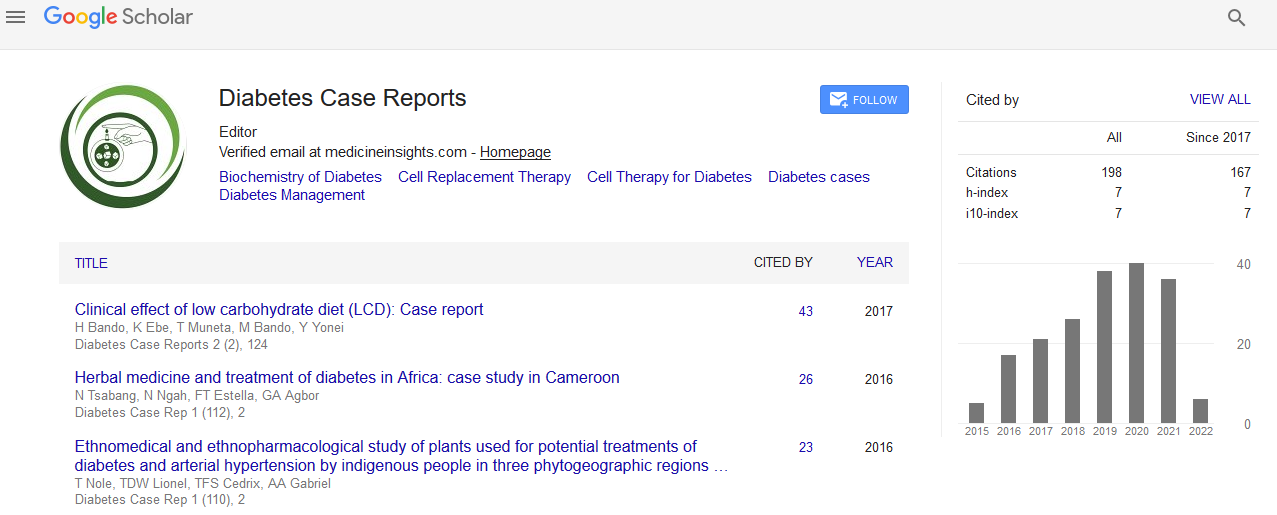Indexed In
- RefSeek
- Hamdard University
- EBSCO A-Z
- Euro Pub
- Google Scholar
Useful Links
Share This Page
Journal Flyer

Open Access Journals
- Agri and Aquaculture
- Biochemistry
- Bioinformatics & Systems Biology
- Business & Management
- Chemistry
- Clinical Sciences
- Engineering
- Food & Nutrition
- General Science
- Genetics & Molecular Biology
- Immunology & Microbiology
- Medical Sciences
- Neuroscience & Psychology
- Nursing & Health Care
- Pharmaceutical Sciences
Opinion - (2023) Volume 8, Issue 6
Complex Nature of Arsenic Metabolism and Its Implications for Type 2 Diabetes
Maged Matthew*Received: 01-Nov-2023, Manuscript No. DCRS-23-24173; Editor assigned: 03-Nov-2023, Pre QC No. DCRS-23-24173(PQ); Reviewed: 23-Nov-2023, QC No. DCRS-23-24173; Revised: 01-Dec-2023, Manuscript No. DCRS-23-24173(R); Published: 08-Dec-2023, DOI: 10.35841/2572-5629-23.8.187
Description
Arsenic is a toxic metalloid that can cause various health problems, such as cancer, cardiovascular disease, and diabetes. Arsenic exposure can occur through drinking water, food, or other environmental sources. Arsenic can exist in different chemical forms, such as Inorganic Arsenic (iAs), Monomethylated Arsenic (MMA), and Dimethylated Arsenic (DMA). These forms have different toxicities and biological effects, depending on how they are metabolized in the body. Arsenic metabolism is the process of converting iAs to MMA and then to DMA, which are then excreted in urine. The relative proportions of these forms in urine can reflect the efficiency of arsenic metabolism and the susceptibility to arsenic toxicity. However, the association between arsenic exposure and Type 2 Diabetes Mellitus (T2DM) is not consistent across different populations and settings. The association between urinary arsenic metabolism and T2DM has been investigated in several epidemiological studies, using different biomarkers and methods. Urinary arsenic metabolism can be assessed by measuring the Total Arsenic Concentration (ΣAs), which is the sum of iAs, MMA, and DMA, or by calculating the percentage of each form over ΣAs (iAs%, MMA %, and DMA%).
The biological mechanisms underlying the association between urinary arsenic metabolism and T2DM are not fully elucidated, but may involve several pathways, such as oxidative stress, inflammation, apoptosis, and epigenetic changes. Oxidative stress can damage cellular components, such as lipids, proteins, and DNA, and impair the function of insulin-producing β-cells and insulin-responsive tissues, such as liver, muscle, and adipose tissue. Arsenic can also trigger inflammation by activating nuclear factor-κB (NF-κB) and pro-inflammatory cytokines, such as Tumour Necrosis Factor-α (TNF-α), Interleukin-6 (IL-6), and CReactive Protein (CRP). Inflammation can interfere with insulin signaling and glucose uptake, and promote insulin resistance and β-cell dysfunction. Arsenic can also induce apoptosis by activating caspases and mitochondrial pathways, and inhibit cell proliferation by modulating cyclins and cyclin-dependent kinases. Apoptosis can reduce the mass and function of β-cells and impair glucose homeostasis. Arsenic can also alter the epigenetic regulation of gene expression by affecting DNA methylation, histone modification, and microRNA expression. Epigenetic changes can affect the expression of genes involved in glucose metabolism, insulin secretion, and insulin sensitivity, and influence the susceptibility and progression of T2DM.
The effects of arsenic on these pathways may depend on the metabolic form and the dose of arsenic, as well as the genetic and nutritional factors that influence arsenic metabolism. For example, MMA is more toxic than iAs and DMA, and can cause more oxidative stress, inflammation, and apoptosis. Therefore, higher MMA% and lower DMA% may indicate higher arsenic toxicity and higher risk of T2DM. However, the dose-response relationship between arsenic and T2DM may not be linear, and may have a threshold or a U-shaped curve. For example, low doses of arsenic may have some beneficial effects, such as stimulating antioxidant defense and insulin secretion, while high doses of arsenic may have detrimental effects, such as inducing oxidative damage and insulin resistance. Moreover, the genetic and nutritional factors that influence arsenic metabolism may also modulate the effects of arsenic on T2DM. Similarly, nutritional factors, such as folate and vitamin B12, which are involved in one-carbon metabolism, may affect the availability of methyl groups for arsenic methylation, and the interaction between arsenic and one-carbon metabolism. For example, folate deficiency may impair arsenic methylation and increase MMA%, while folate supplementation may enhance arsenic methylation and decrease MMA%. Therefore, the association between urinary arsenic metabolism and T2DM may vary by the genetic and nutritional status of the individuals.
Conclusion
The association between urinary arsenic metabolism and T2DM has important implications for the prevention and management of T2DM, especially in areas with high arsenic exposure. Urinary arsenic metabolism can be used as a biomarker to assess the exposure level and the metabolic efficiency of arsenic, and to identify the individuals who are at higher risk of arsenic toxicity and T2DM. Moreover, urinary arsenic metabolism can be modified by genetic and nutritional interventions, which may reduce the toxicity and the risk of T2DM. For example, screening for genetic polymorphisms that affect arsenic metabolism, and providing folate and vitamin B12 supplementation to individuals with impaired arsenic methylation, may be potential strategies to prevent or delay the onset of T2DM. Furthermore, urinary arsenic metabolism can be used as a surrogate endpoint to evaluate the efficacy of pharmacological and non-pharmacological interventions for T2DM, such as metformin, pioglitazone, and lifestyle modification, which may affect arsenic metabolism and toxicity.
Citation: Matthew M (2023) Complex Nature of Arsenic Metabolism and Its Implications for Type 2 Diabetes. Diabetes Case Rep. 8:187.
Copyright: © 2023 Matthew M. This is an open-access article distributed under the terms of the Creative Commons Attribution License, which permits unrestricted use, distribution, and reproduction in any medium, provided the original author and source are credited.

